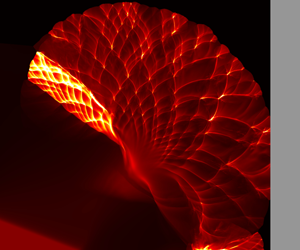Crossref Citations
This article has been cited by the following publications. This list is generated based on data provided by
Crossref.
Yuan, X. Q.
Yan, C.
Zhou, J.
and
Ng, H. D.
2021.
Computational study of gaseous cellular detonation diffraction and re-initiation by small obstacle induced perturbations.
Physics of Fluids,
Vol. 33,
Issue. 4,
Radulescu, M. I.
Mével, R.
Xiao, Q.
and
Gallier, S.
2021.
On the self-similarity of diffracting gaseous detonations and the critical channel width problem.
Physics of Fluids,
Vol. 33,
Issue. 6,
Wang, Yuan
Chen, Zheng
and
Chen, Haitao
2021.
Diffraction of weakly unstable detonation through an obstacle with different sizes and shapes.
Physical Review Fluids,
Vol. 6,
Issue. 4,
Zhang, Zijian
Wen, Chihyung
Zhang, Wenshuo
Liu, Yunfeng
and
Jiang, Zonglin
2021.
Formation of stabilized oblique detonation waves in a combustor.
Combustion and Flame,
Vol. 223,
Issue. ,
p.
423.
Peswani, Mohnish
and
Maxwell, Brian
2022.
Detonation wave diffraction in stoichiometric C2H4/O2 mixtures using a global four-step combustion model.
Physics of Fluids,
Vol. 34,
Issue. 10,
Thethy, Bhavraj S.
Rezay Haghdoost, Mohammad
Kirby, Rhiannon
Seo, Bonggyun
Nadolski, Maikel
Zenker, Christian
Oevermann, Michael
Klein, Rupert
Oberleithner, Kilian
and
Edgington-Mitchell, Daniel
2022.
Diffraction of shock waves through a non-quiescent medium.
Journal of Fluid Mechanics,
Vol. 944,
Issue. ,
Zhang, Zijian
Liu, Yunfeng
and
Wen, Chihyung
2022.
Mechanisms of the destabilized Mach reflection of inviscid oblique detonation waves before an expansion corner.
Journal of Fluid Mechanics,
Vol. 940,
Issue. ,
Shamsadin Saeid, Mohammad Hosein
and
Ghodrat, Maryam
2022.
Numerical Simulation of the Influence of Hydrogen Concentration on Detonation Diffraction Mechanism.
Energies,
Vol. 15,
Issue. 22,
p.
8726.
Sun, Han
Kawasaki, Akira
Itouyama, Noboru
Matsuoka, Ken
and
Kasahara, Jiro
2022.
Experimental study on detonation-diffraction reflection point distances in hydrogen and gaseous hydrocarbon reactive systems.
Combustion and Flame,
Vol. 245,
Issue. ,
p.
112329.
Sun, Xuxu
Yan, Chian
Yan, Yiran
Mi, Xiaocheng
Lee, John H.S.
and
Dick Ng, Hoi
2022.
Critical tube diameter for quasi-detonations.
Combustion and Flame,
Vol. 244,
Issue. ,
p.
112280.
Floring, Grace
Peswani, Mohnish
and
Maxwell, Brian
2023.
On the role of transverse detonation waves in the re-establishment of attenuated detonations in methane–oxygen.
Combustion and Flame,
Vol. 247,
Issue. ,
p.
112497.
Lai, S.
Tang, S.
Xu, C.
Sekularac, N.
and
Fang, X.
2023.
Computational diagnostics for flame acceleration and transition to detonation in a hydrogen/air mixture.
Combustion and Flame,
Vol. 258,
Issue. ,
p.
113054.
Wen, Chih-Yung
Jiang, Yazhong
and
Shi, Lisong
2023.
Space–Time Conservation Element and Solution Element Method.
Vol. 13,
Issue. ,
p.
95.
Shi, Lisong
Fan, E
Shen, Hua
Wen, Chih-Yung
Shang, Shuai
and
Hu, Hongbo
2023.
Numerical Study of the Effects of Injection Conditions on Rotating Detonation Engine Propulsive Performance.
Aerospace,
Vol. 10,
Issue. 10,
p.
879.
Yan, Chian
Ng, Hoi Dick
and
Mi, Xiaocheng
2023.
A numerical study on the influence of increased instability of quasi-detonation on the critical tube diameter phenomenon.
Proceedings of the Combustion Institute,
Vol. 39,
Issue. 3,
p.
2835.
Hu, Jiehui
Cheng, Jun
and
Zhang, Bo
2023.
The diffraction and re-initiation behavior of detonation wave in premixed H2–O2–Ar mixture.
Physics of Fluids,
Vol. 35,
Issue. 9,
Zangene, Farzane
Xiao, Qiang
and
Radulescu, Matei
2023.
Critical diffraction of irregular structure detonations and their predictability from experimentally obtained D−κ data.
Proceedings of the Combustion Institute,
Vol. 39,
Issue. 3,
p.
2935.
Venkataraman, Ashwath Sethu
Balci, Ebuzer Tarik
Farah, Hoden
and
Oran, Elaine S.
2024.
Calibration of the Chemical-Diffusive Model and its effects on C2H4-air detonation dynamics.
Proceedings of the Combustion Institute,
Vol. 40,
Issue. 1-4,
p.
105731.



